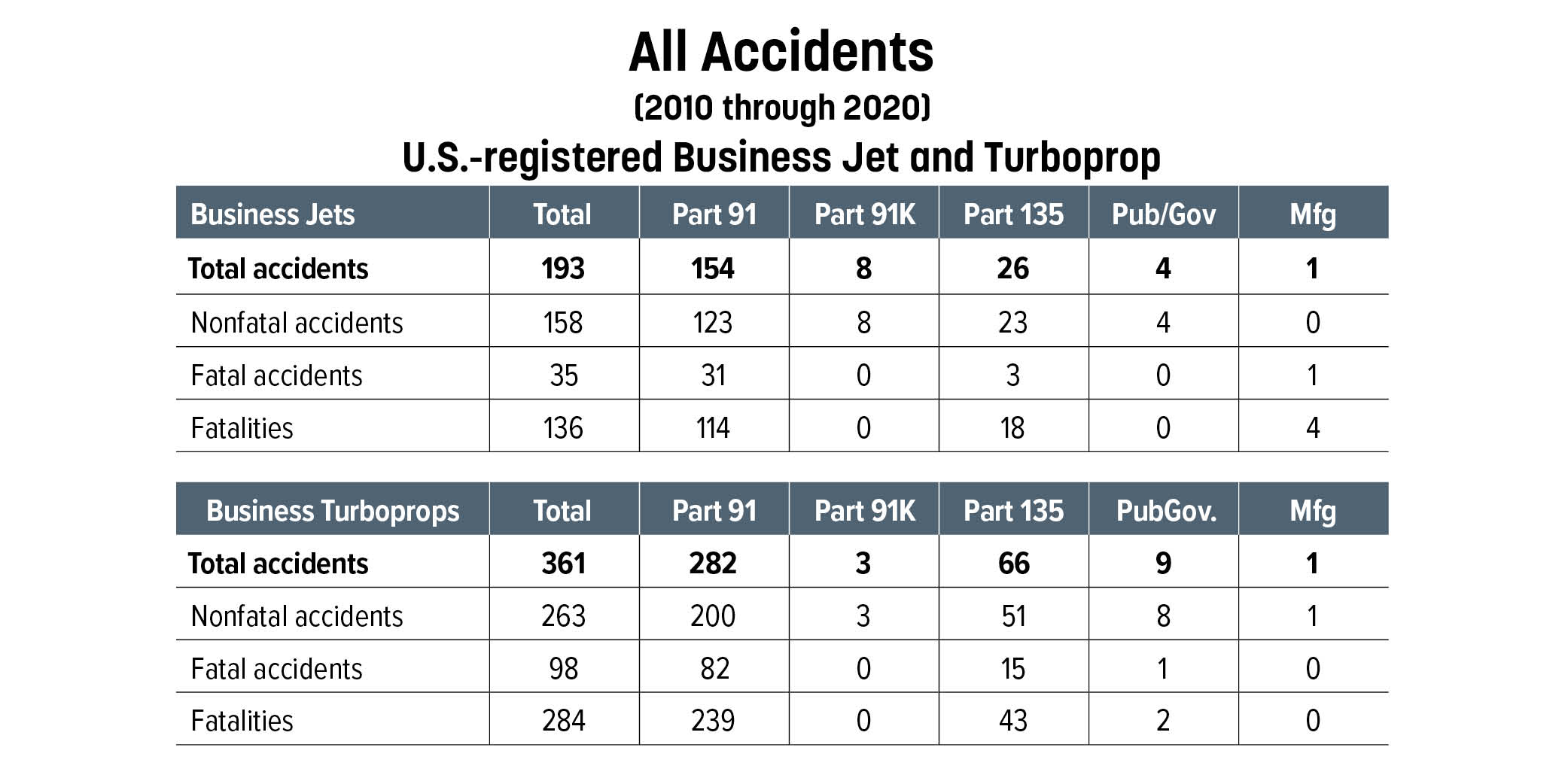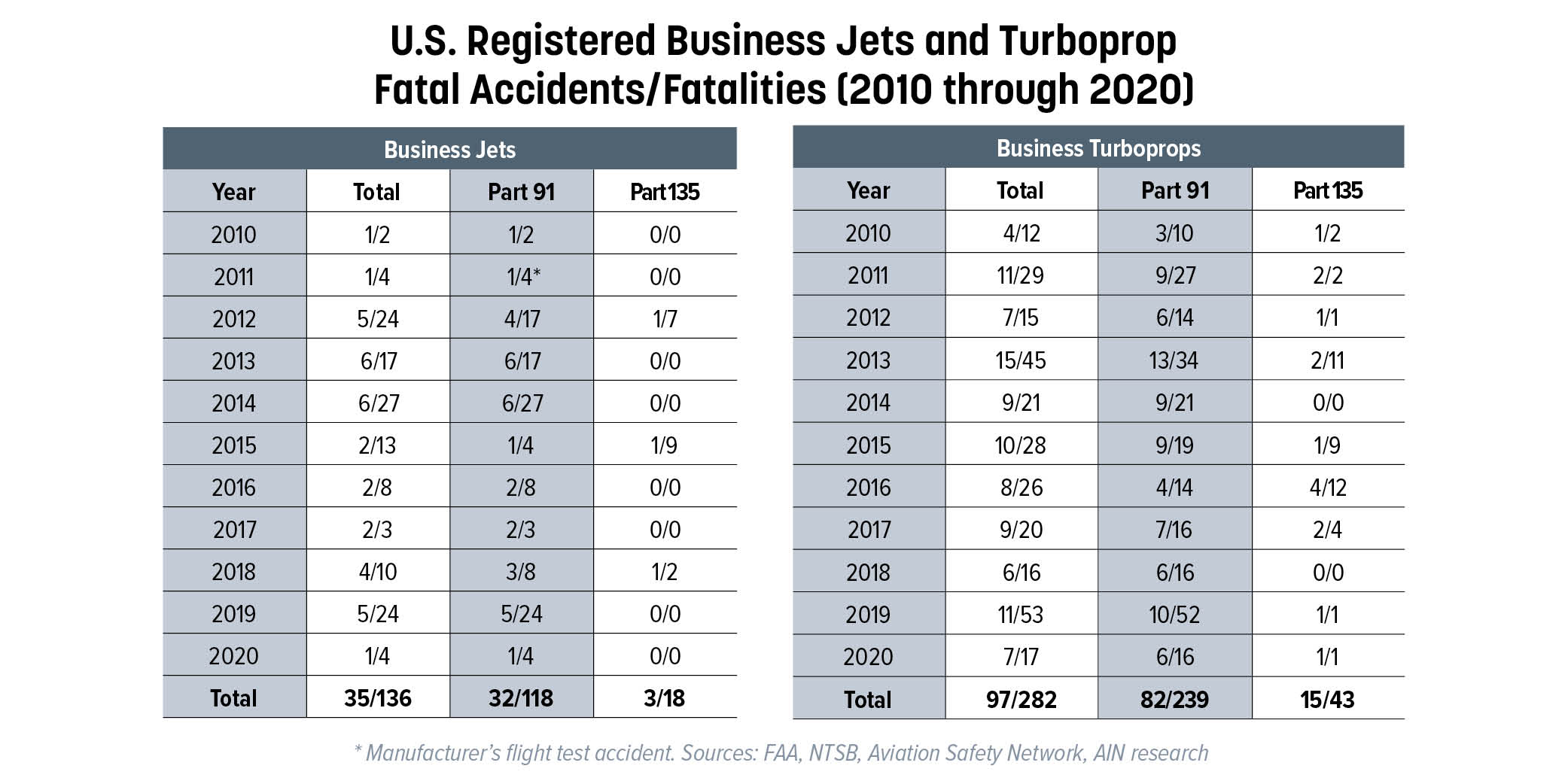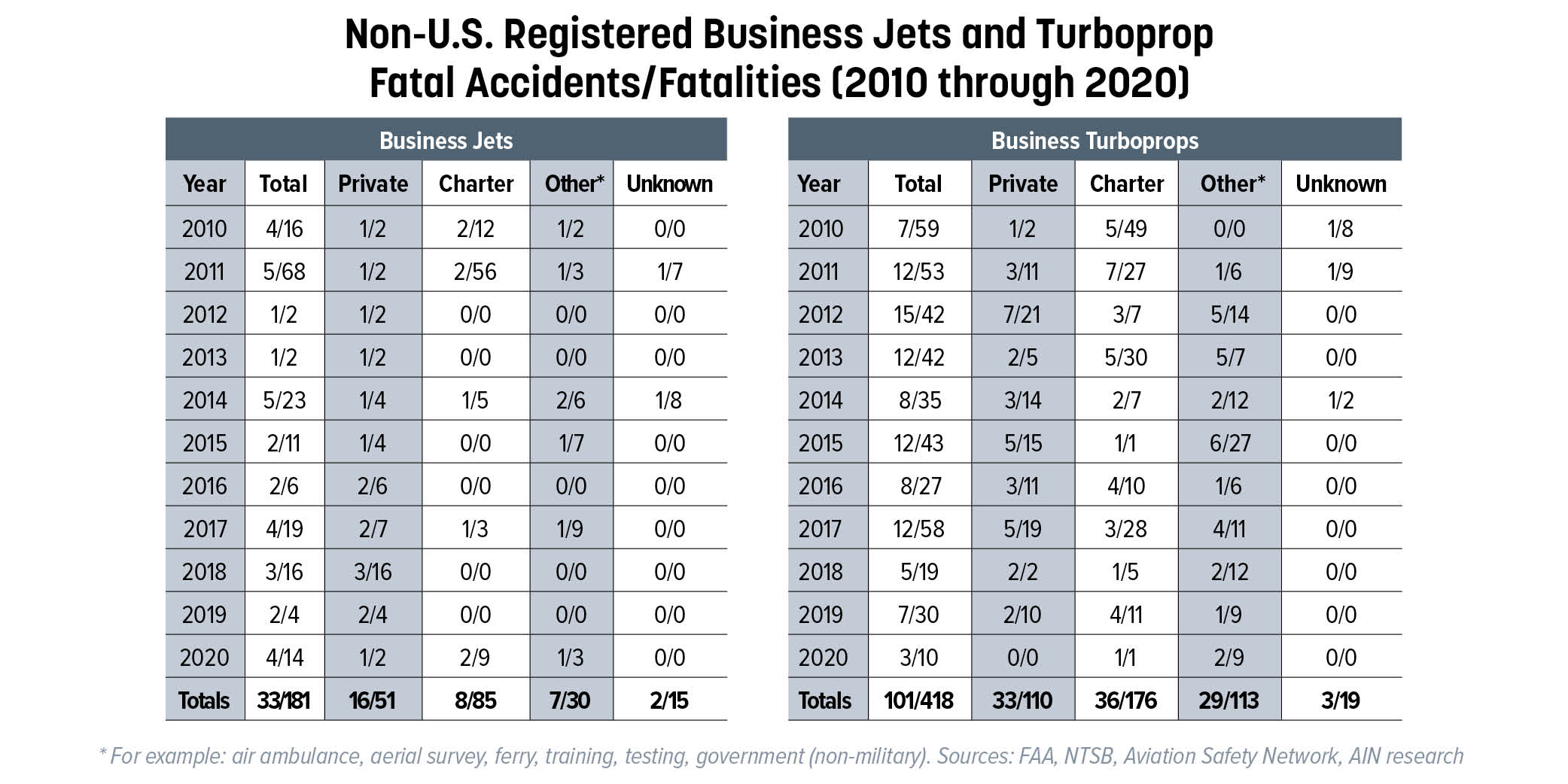Click Here to View This Page on Production Frontend
Click Here to Export Node Content
Click Here to View Printer-Friendly Version (Raw Backend)
Note: front-end display has links to styled print versions.
Content Node ID: 405062
An AIN review of aviation accidents worldwide between 2010 and 2020 revealed that business jets were involved in 300 crashes, of which less than a quarter—68—were fatal, resulting in the deaths of 317 people. The review also showed that business turboprops suffered 610 crashes, of which nearly a third—199—were fatal, costing 702 lives.
Private operations accounted for the largest number of accidents, as well as the vast majority of flying hours. According to AIN research, 206 business jet accidents—some 70 percent of the total—occurred under Part 91 regulations, of which 47, just shy of a quarter of all private flight accidents, ended in fatalities. As for business turboprops, 369—or about 60 percent of the total number of crashes—were flying as private missions. Of these accidents, fatalities occurred in 115—or just over 31 percent.
The U.S. accounts for nearly two-thirds of the world’s business jet fleet and a corresponding number of flight hours, so it is not surprising that the total number of accidents of N-numbered business jets—193—was just short of twice as many as the 107 involving non-U.S. registered jets.
However, over the last decade, fatal accidents of non-U.S.-registered business jets accounted for 31 percent of the total, while N-numbered business jet fatal accidents comprised just over 18 percent of all accidents despite the fact that both segments had virtually the same amount of fatal accidents—33 for non-U.S. versus 35 for the U.S. Additionally. the number of U.S. jet fatalities averaged less than four per accident versus more than five victims per accident for crashes of non-U.S.-registered jets.
Except for the non-U.S.-registered business turboprop segment, there were significantly fewer charter accidents and fatalities compared to private mishaps in the past decade. Yet, the ratio of fatal charter crashes to the number of total charter accidents was about the same as for the private segment: 1:3.5, meaning one fatal accident for every 3.5 accidents. What’s more, because there are often more occupants per charter flight versus a private flight, the number of fatalities per charter accident was generally more compared to the private (Part 91) segment.
Charts accompanying this article depict the statistics in more detail, breaking down the numbers by U.S. registered compared with non-U.S. registered aircraft and the regulatory segment under which the flight was operating at the time of the mishap. It can be seen from the charts that there was one fatal crash during a manufacturer's test flight and that there have been no fatal accidents involving fractional operations in the last 10 years (or in any year on record, for that matter).

U.S. Jet Charter Operators Excelled
Fatal accidents occurring during charter operations of non-N-numbered business jets exceeded their U.S. counterparts profoundly: three times as many fatal mishaps and more than five times as many who perished. Non-N-numbered business jets experienced 85 fatalities in eight charter accidents over the last decade, compared with 18 who perished in three Part 135 on-demand operations flying N-numbered business jets.
On Dec. 9, 2012, the two pilots and five passengers died when their U.S.-registered Learjet 25 crashed into mountainous terrain while en route on a charter flight between Monterrey and Toluca, Mexico. According to the final investigation report, the twinjet was at 28,800 feet when it descended abruptly and crashed into terrain at about 5,600 feet msl.
Accident investigators concluded that the pilots lost control of the aircraft for undetermined reasons. Investigation of the destroyed aircraft revealed no pre-impact damage to flight controls. Also, investigators had unanswered questions about the pilot’s qualifications.
The second U.S. charter fatal crash of the last decade was on Nov.10, 2015, when a British Aerospace Hawker 700A that “departed controlled flight” while on a localizer approach to Runway 25 at Akron Fulton International Airport in Ohio crashed into an apartment building, killing the two pilots and seven passengers. Instrument meteorological conditions existed and an IFR flight plan was filed.
The NTSB determined the probable cause of this accident to be the pilots’ “mismanagement of the approach and multiple deviations from company standard operating procedures, which placed the airplane in an unsafe situation and led to an unstabilized approach; a descent below the MDA without visual contact with the runway environment; and an aerodynamic stall.”
Contributing to the accident were the charter company’s “casual attitude toward compliance with standards; its inadequate hiring, training, and oversight of the flight crew; the company’s lack of a formal safety program;” and the FAA’s insufficient monitoring of the company.
The third Part 135 on-demand fatal accident of the last decade occurred on Sept. 27, 2018 when a Dassault Falcon 50 was unable to stop after landing, went off the end of the runway, and crashed through a perimeter fence before impacting terrain killing the two pilots and seriously injuring the two passengers. Although the NTSB classified this as a Part 135 operation, there are questions about whether it was an illegal charter. The NTSB determined the probable causes of this accident to be: “The operator's decision to allow a flight in an airplane with known, unresolved maintenance discrepancies, and the flight crew's failure to properly configure the airplane in a way that would have allowed the emergency or parking brake systems to stop the airplane during landing.” 

Jet and Turboprop Comparisons
Business jets and turboprops worldwide were involved in at least one fatal accident every year between 2010 and 2020. As previously noted, all but three N-numbered jet fatal crashes happened under Part 91. Private non-N-numbered business jets sustained about half the number of fatal accidents and fatalities as U.S. private operations.
The one Part 91 fatal involving an airframe manufacturer’s operations occurred on April 2, 2011, when an experimental Gulfstream G650 crashed following a stall and uncommanded roll during an intentional one-engine inoperative takeoff, killing the two pilots and the two flight-test engineers. The NTSB attributed the accident to Gulfstream’s “failure to properly develop and validate takeoff speeds for the flight tests, and recognize and correct the takeoff safety speed (V2) error during previous G650 flight tests; the flight-test team’s persistent and increasingly aggressive attempts to achieve V2 speeds that were erroneously low; and Gulfstream’s inadequate investigation of previous G650 uncommanded roll events, which indicated that the company’s estimated stall angle of attack, while the airplane was in ground effect, was too high.”
Accidents involving business turboprop operations typically exceed those incurred by their turbojet/turbofan counterparts, and that was indeed the case in the last decade. The number of fatal accidents was very close for N-numbered and non-N-numbered turboprops, but the number of occupants who perished in non-U.S.-registered turboprop accidents was nearly 1.5 times that for those involving U.S.-registered turboprops.
That said, non-U.S.-registered turboprops involved in private operations suffered significantly fewer crashes and fatalities than U.S. Part 91 turboprop operations. The number of accidents that didn’t result in fatalities was essentially the same for charter operations of both U.S.- and non-U.S.-registered turboprops, but the number of non-U.S. fatal charter accidents was more than double that of U.S. turboprops and the fatality count four times as many.
The numbers in this article have referred to all U.S and non-U.S. registered business jet and turboprops flying worldwide under regulations covering private, charter, positioning/ferry, testing, training, surveying, ambulance, non-military government transportation, and head-of-state. Not included in these statistics are accidents involving all-cargo aircraft and those occurring during illegal flights, shoot-downs, and deliberate actions, such as suicides.